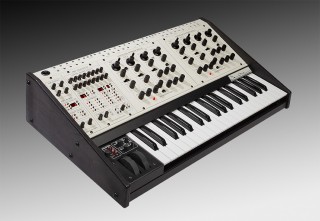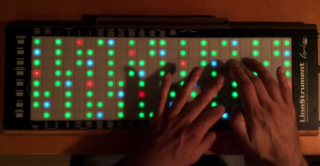Electronic music instrument pioneers Tom Oberheim and Roger Linn have created some of the most important electronic music instruments of the last 4 decades.
In this video, they demonstrate what happens when you put together two of their instruments – designed 40 years apart.
 Tom Oberheim’s Two Voice synthesizer was originally release 40 years ago, in 1975. Oberheim calls it his favorite synth design, and earlier this year he debuted an updated version.
Tom Oberheim’s Two Voice synthesizer was originally release 40 years ago, in 1975. Oberheim calls it his favorite synth design, and earlier this year he debuted an updated version.
Roger Linn’s LinnStrument is a new MIDI controller design that supports three dimensions of polyphonic performance control. It can sense the movement of each of your fingers in three directions. For example:
- finger pressure (Z axis) can be used to vary note loudness;
- finger left-right (X axis) movement can be used to vary pitch; and
- finger forward-backward (Y axis) movement can be used to vary timbre.
 This flexible range of performance control has been rare in electronic music controllers. It is becoming accessible to a broader range of musicians, though, because of the availability of instruments like the LinnStrument, the Roli Rise, the Haken Continuum and others.
This flexible range of performance control has been rare in electronic music controllers. It is becoming accessible to a broader range of musicians, though, because of the availability of instruments like the LinnStrument, the Roli Rise, the Haken Continuum and others.
The video highlights how forward-thinking Oberheim was with his original two-voice design, and how forward-thinking Oberheim and Linn are still today.

I like it.
U$ 20,00 !?
Love Tom’s subtle wow when Roger riffs (1min12).
I think only Roger Linn use the LinnStrument.
Nope. There’s a dedicated and excited core of Linnstrument users. Check ’em out here:
http://www.kvraudio.com/forum/viewforum.php?f=263&sid=8376512cc5326baa97d120a14741d77f
Great stuff – but I wish more keyboards came out with that degree of expression. I’m a keyboardist since 50 years, and that’s where my hands want to go. I’ve two keyboards that have touch vibrato, a Yamaha YC-45D (1980’s) and an Ondioline (1950’s!). I also have the new Roli which is a seaboard more than a keyboard.
Come on keyboard makers – give us 3-way expression please!
I don’t understand how you imagine it can be done.
A keyboard already has 3+ mods of expression depending on the setup, but I guess here, we are talking 3 axis of control on each finger across every key. And the original design of the Linnstrument was suppose to have a few layouts including conventional keys, but it stops the axis of pitch change working, because of the manner a keyboard is sprawled out.
So, pressure and aftertouch is a given on one axis. You could have some modulation on the movement of conduction/pressure/tilt of each key, like a Seaboard (pressure) or Qunexus (tilt). Then that leaves that last right/left movement, that you would have as pitch bend, that can’t work on a piano keyboard layout. As you need to give all keys equal spacing and alignment for that to work, and the keyboard layout got hodgepodged together over time to work in some stupid way – like a qwerty keyboard, we get stuck with an archaic setup due to dynamics from the past that no longer have any relevance – so best to leave the piano keyboard layout where it belongs, in the past.
One major issue I find, I make music on a piano layout I get lost and confused, then I do it on a grid layout it suddenly makes sense and has direction – I no longer use keys.
Hi Kuwa,
A traditional MIDI keyboard does have Aftertouch, bend and mod wheels but my view is that these don’t permit the level of expression that a violinist, sax player, guitarist or other player of fine acoustic instruments gets. For example:
* Keyboard Aftertouch only starts after the key is all the way down, whereas LinnStrument’s pressure out starts at the lightest touch, permitting performance of wind and bowed-string sounds which gradually increase in level at the start of the note.
* A bend wheel does permit pitch bending, but I’d argue that it doesn’t provide the subtlety of LinnStrument’s integration of pitch control into the note itself, just like a violin or cello.
* A mod wheel does permit vibrato, but I’d argue that fading in a mathematically perfect LFO vibrato the same on every note doesn’t sound the same as performing vibrato on LinnStrument by wiggling your finger, just as on a violin..
* A MIDI keyboard doesn’t permit the 3rd dimension of timbre control as on LinnStrument.
* LinnStrument permits independent 3D control of every simultaneous touch.
To help demonstrate what I mean, please watch this video of me playing viola on LinnStrument:
https://www.youtube.com/watch?v=chNAY8gz2SY
You can also see lots more videos on my site, rogerlinndesign.com.
Oops– . I didn’t read your comment correctly.
Oops– sorry, Kuwa. My flight was about to take off and I misread your email in my rush. I now see that you already understood what I was trying to say.
Yes, it is OK. I was reading your comment and thinking I am sure I was kinda saying that, my fault for being a little convoluted. Loving your work on the Linnstrument.
Hi Morgan,
Have you tried TouchKeys?:
http://www.eecs.qmul.ac.uk/~andrewm/touchkeys.html
I think it’s a good compromise for those who want the feel of a traditional keyboard.
every day is a step closer to the star wars cantina band
Great video! The only thing missing for me is a little more detail how they are connecting the two.
MIDI?
Hi Robert,
I connected a single MIDI cable from LinnStrument’s MIDI Out to the Two Voice’s MIDI In.
The Linnstrument is obviously incredible. I can’t wait to get my hands on one. Roger Linn is my hero!
Hi Paul,
Thank you for your very kind compliment!
Roger, please remake the LinnDrum! You’re very forward thinking, which I love, but don’t forget your glorious past.
Hi Mikkel,
I’m working on a new drum machine but I’m sorry to say it won’t be a reissue of an old product. It seems to me that people make music differently than in 1982 and therefore need new ideas, plus to be honest the future is more fun for me than the past. 🙂 For an idea of where I’m heading, check out Tempest and also this video:
http://youtu.be/HHWrSs8o1V4
– Roger typing in-flight
I understand that you would rather make new products, with new ideas, than rehash old products.
However, I think today there’s quite a big market for 80’s style (if you will) music making. I don’t think a lot of people make 80’s music, strictly speaking. But I think a lot of people make music carrying the same sensibility and style.
I watched the Linnstrument video, and personally, I don’t need all the ‘fluent’ modulation options this provides. I couldn’t care less for jazz or any of the other genres that keeps popping up when showcasing this instrument, or discussing it’s capabilities.
RIght now we live in a time where a lot of the ‘classics’ are being reborn, either quite precisely or not so much. I am an owner of the Prophet 6 and I think Dave Smith struck a nice balance between great achievements of yesterday, while adding new features.
Didn’t I read a story once, about Roger Linn being quite surprised on how the Linn drum was actually used. It had all these great ways of programming drums, but the kids (Human League et al) used it as a simple rhythm machine? Somehow, if the the Linn drum was reissued, I think it would be selling like hotcakes. Simplicity is the keyword. To me, the Linnstrument is anything but.
“Twony??”
So Good!
Roger a privilege to read your posts.
To have inspired millions worldwide.
Couldn’t agree more..
Can’t wait to see what the future holds for the Linnstrument, especially where it can be taken in terms of micronal polyphony!
Looking very forward to hearing more details of this new drum machine!
Yes. Good to see the passion. I really respect the Linnstrument’s dev, each step along the way I thought the product would get compromised, but it didn’t. It evolved with purpose and intent. The R&D seemed transparent and fluid and the product benefited from that so much – I look forward to owning one in the near future.
I recall being blown away with this:
https://www.youtube.com/watch?v=AoAOx97G8ew